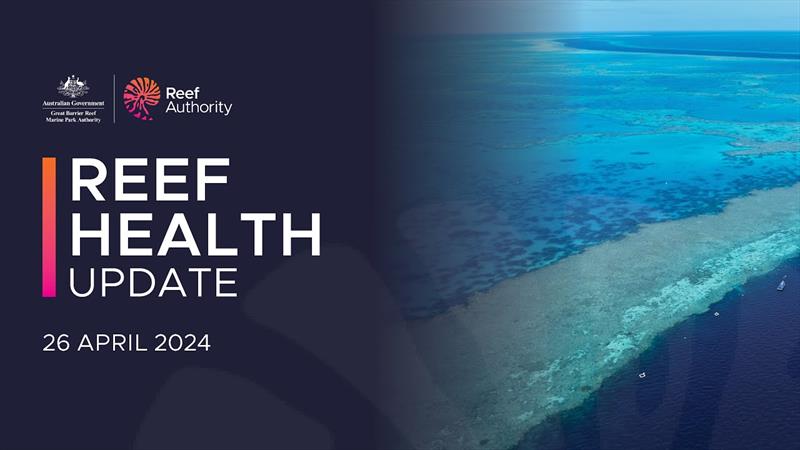
Great Barrier Reef health update
by Great Barrier Reef Marine Park Authority 27 Apr 06:16 UTC

Reef health update | 26 April 2024 © Great Barrier Reef Marine Park Authority
As the lead managers of the Great Barrier Reef, the Reef Authority keeps an eye on the Reef year-round — with efforts stepped up over summer, a typically high-risk period from extreme weather.
Over summer the Reef Authority releases weekly updates on how the Reef is faring with a focus on sea surface temperatures, rainfall and floods, cyclones, crown-of-thorns starfish outbreaks, and coral disease.
These updates are based on forecasts, water temperature heat mapping, in-water surveys, citizen science and aerial surveys.
Reef health update | 26 April 2024
Sea surface temperatures across the whole Great Barrier Reef Marine Park have now cooled to below the average summer maximum.
Sea surface temperatures are now below the threshold that typically causes heat stress to corals. However, temperatures are still higher than average for April.
Over the coming months, the Reef Authority will continue working with our partners from Queensland Parks and Wildlife Service under the Reef Joint Field Management Program, the Australian Institute of Marine Science, COTS Control Program, Tourism Operators, and researchers to continue in-water surveys to determine the effects of coral bleaching at varying depths and habitats. This data, alongside the Long-term Monitoring Program information from the Australian Institute of Marine Science, will allow us to quantify any coral mortality that has occurred this summer.
This is our last weekly Reef Health Update for the 2023-24 summer. From May, we will continue to keep you updated with what's happening in the Marine Park with monthly updates via this page, and on the Reef Authority's social media accounts.
Reef health
A total of 730 in-water surveys were conducted in the Marine Park between 10 April-24 April, of which 690 were Reef Health Impact Surveys.
Coral bleaching was reported on all surveyed reefs. Most reefs surveyed in the Southern Regions had more than 60 per cent of coral cover with coral beaching. Most reefs surveyed in the Central Region exhibited coral bleaching on more than 10 per cent of coral cover while reefs north had more than 30 per cent of coral cover bleached. Variable levels of coral mortality were observed in the Southern and Central regions.
In the Central region, some minor impacts of damage (e.g. anchor damage, fishing lines etc) and disease were recorded. Mostly no impacts of damage and disease were recorded in the Northern and Southern regions.
The Crown-of-thorns starfish (CoTS) control program has reported emerging primary outbreaks near Lizard Island and offshore Port Douglas. There are also isolated outbreaks offshore Townsville and the Whitsundays, and persistent outbreaks in the offshore Swains Reefs.
Temperature
In some welcome news, the sea surface temperatures across the whole Marine Park have now cooled to below the average summer maximum.
However, the sea surface temperatures remain above the long-term monthly average for April, with temperatures 1.5 degreesC above average in the Northern Region; 1.25 degreesC above average in the Central; and 1 degreesC above average in the Southern Region.
While water temperatures are above the monthly average, they are below the threshold that typically causes heat stress to corals.
Rainfall
Heavy rainfall of up to 300mm was received in the Cape York Catchment this past week, but this has not affected the increasing salinity levels north of Cairns. Salinity levels in this area are forecasted to continue increasing to near average levels next week.
There is a chance that increased cloud and rainfall in the Western Pacific this week could result in increased showers across parts of far northern Queensland.
Reef management
The Reef Authority is working closely with the Australian Institute of Marine Science and the broader observer network to complete further surveys to get a better understanding of the full extent and severity of coral bleaching across the Great Barrier Reef. We will continue to report on what we find, in monthly Reef Health Updates from May.
Staff from the Australian and Queensland government are out patrolling the Marine Park as part of the Reef Joint Field Management Program, monitoring and ensuring zoning laws and Marine Park rules are being followed.
Everyone who visits the Great Barrier Reef can do their bit to help protect it. When anchoring boats:
- Use public moorings where available and do not anchor within no-anchoring areas - they are there to protect the coral.
- Where possible, anchor in sand or mud away from corals and other fragile marine environments. Suitable areas often show up as flat and smooth on your sounder.
- Never wrap anchor rope or chain around bommies or large coral heads.
- If anchoring overnight, anchor before nightfall and double-check the swing room.
- Use your sand anchor and reef pick appropriately to minimise damage.
- Motor towards the anchor when hauling it in and retrieve the anchor when the line is vertical.
- If the anchor is caught on a reef, free it by hand wherever possible.
- Do not force the anchor free by motoring forward.
- Keep watch to make sure the anchor isn't dragging.